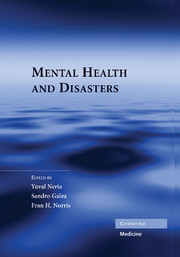Crossref Citations
This Book has been
cited by the following publications. This list is generated based on data provided by Crossref.
Shultz, James M.
Marcelin, Louis Herns
Madanes, Sharon B.
Espinel, Zelde
and
Neria, Yuval
2011.
The “Trauma Signature:” Understanding the Psychological Consequences of the 2010 Haiti Earthquake.
Prehospital and Disaster Medicine,
Vol. 26,
Issue. 5,
p.
353.
Shultz, James M.
Kelly, Fiona
Forbes, David
Verdeli, Helen
Leon, Gloria R.
Rosen, Alexa
and
Neria, Yuval
2011.
Triple Threat Trauma: Evidence-Based Mental Health Response for the 2011 Japan Disaster.
Prehospital and Disaster Medicine,
Vol. 26,
Issue. 3,
p.
141.
Cutter, Susan
Osman-Elasha, Balgis
Campbell, John
Cheong, So-Min
McCormick, Sabrina
Pulwarty, Roger
Supratid, Seree
Ziervogel, Gina
Calvo, Eduardo
Mutabazi, Khamaldin Daud
Arnall, Alex
Arnold, Margaret
Bayer, Joanne Linnerooth
Bohle, Hans-Georg
Emrich, Christopher
Hallegatte, Stephane
Koelle, Bettina
Oettle, Noel
Polack, Emily
Ranger, Nicola
Rist, Stephan
Suarez, Pablo
and
Wilches-Chaux, Gustavo
2012.
Managing the Risks of Extreme Events and Disasters to Advance Climate Change Adaptation.
p.
291.
Pfefferbaum, Betty
Tucker, Phebe
Jeon-Slaughter, Haekyung
Allen, James R.
Hammond, Donna R.
Whittlesey, Suzanne W.
Vinekar, Shreekumar S.
and
Feng, Yan
2013.
A Pilot Study of Physiological Reactivity in Children and Maternal Figures Who Lost Relatives in a Terrorist Attack.
Death Studies,
Vol. 37,
Issue. 5,
p.
395.
Axinn, William G.
Ghimire, Dirgha J.
Williams, Nathalie E.
and
Scott, Kate M.
2013.
Gender, Traumatic Events, and Mental Health Disorders in a Rural Asian Setting.
Journal of Health and Social Behavior,
Vol. 54,
Issue. 4,
p.
444.
van der Velden, Peter G.
Wong, Albert
Boshuizen, Hendriek C.
and
Grievink, Linda
2013.
Persistent mental health disturbances during the 10 years after a disaster: Four‐wave longitudinal comparative study.
Psychiatry and Clinical Neurosciences,
Vol. 67,
Issue. 2,
p.
110.
Albright, Glenn
Adam, Cyrille
Goldman, Ron
and
Serri, Deborah
2013.
A Game-Based Simulation Utilizing Virtual Humans to Train Physicians to Screen and Manage the Care of Patients with Mental Health Disorders.
Games for Health Journal,
Vol. 2,
Issue. 5,
p.
269.
Hermosilla, Sabrina
and
Galea, Sandro
2014.
Essentials of Global Mental Health.
p.
316.
Goldmann, Emily
and
Galea, Sandro
2014.
Mental Health Consequences of Disasters.
Annual Review of Public Health,
Vol. 35,
Issue. 1,
p.
169.
von Vacano, Mechthild
and
Zaumseil, Manfred
2014.
Cultural Psychology of Coping with Disasters.
p.
3.
Chan, Christian S.
Rhodes, Jean E.
and
Chao, Linda
2014.
Measuring Exposure in Hurricane Katrina: A Meta-Analysis and an Integrative Data Analysis.
PLoS ONE,
Vol. 9,
Issue. 4,
p.
e92899.
2014.
Essentials of Global Mental Health.
p.
289.
Sever, Rita
2015.
Disaster Management: Enabling Resilience.
p.
201.
Axinn, William G.
Ghimire, Dirgha J.
Williams, Nathalie E.
and
Scott, Kate M.
2015.
Associations between the social organization of communities and psychiatric disorders in rural Asia.
Social Psychiatry and Psychiatric Epidemiology,
Vol. 50,
Issue. 10,
p.
1537.
Hatch, Trevan G.
Cherry, Katie E.
Kytola, Keri L.
Lu, Yaxin
and
Marks, Loren D.
2015.
Traumatic Stress and Long-Term Recovery.
p.
231.
Ng, Guat Tin
and
Sim, Timothy
2015.
Post-disaster school relocation: A case study of Chinese students’ adjustment after the Wenchuan earthquake.
International Social Work,
Vol. 58,
Issue. 1,
p.
7.
Cherry, Katie E.
Sampson, Laura
Nezat, Pamela F.
Cacamo, Ashley
Marks, Loren D.
and
Galea, Sandro
2015.
Long-term psychological outcomes in older adults after disaster: relationships to religiosity and social support.
Aging & Mental Health,
Vol. 19,
Issue. 5,
p.
430.
Stehrenberger, Cécile Stephanie
2016.
Psychische Störungen und sozialwissenschaftliche Katastrophenforschung, 1949–1985.
NTM Zeitschrift für Geschichte der Wissenschaften, Technik und Medizin,
Vol. 24,
Issue. 1,
p.
61.
Dursun, Pinar
Steger, Michael F.
Bentele, Christoph
and
Schulenberg, Stefan E.
2016.
Meaning and Posttraumatic Growth Among Survivors of the September 2013 Colorado Floods.
Journal of Clinical Psychology,
Vol. 72,
Issue. 12,
p.
1247.
Cherry, Katie E.
Sampson, Laura
Galea, Sandro
Marks, Loren D.
Nezat, Pamela F.
Baudoin, Kayla H.
and
Lyon, Bethany A.
2017.
Optimism and Hope After Multiple Disasters: Relationships to Health-Related Quality of Life.
Journal of Loss and Trauma,
Vol. 22,
Issue. 1,
p.
61.



